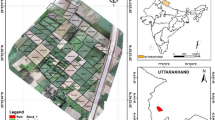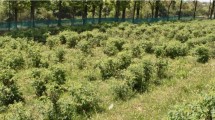Abstract
This paper presents the results and observations made from pilot exercises on crop discrimination using Parraot Sequoia multispectral sensor onboard a Unmanned Arial Vehicle (UAV). The exercise was carried out in two selected sites in West Jaintia Hills district of Meghalaya state with mixed horticultural crops. Parraot Sequoia sensor having four bands has been found to be effective in crop discrimination based on variation in spectral response and crop height. Discrimination of three horticultural crops viz. banana, orange, and plum and the neighbouring bamboo grooves were evaluated using three commonly used indices viz., Normalized Difference Vegetation Index (NDVI), Normalized Difference Red Edge Index (NDRE) and Green Normalized Difference Vegetation Index (GNDVI). NDVI and GNDVI showed nearly similar spectral response, whereas separability among the crops marginally improved with the use of NDRE. The percent variations of spectral response for orange and bamboo were 14 and 19 in terms of NDVI and GNDVI respectively, whereas the same value is 49 in case of NDRE. Similarly percent variations of spectral response for banana and bamboo were 7 and 15 in terms of NDVI and GNDVI against 27 in case of NDRE. In the second study site, variation in Digital Surface Model (DSM) and Digital Terrain Model (DTM) was generated to discriminate different crops grown at different elevation. The difference in the surface model has helped in discriminating different crops and other neighboring vegetation with rice recording difference of − 0.05 to 0.05, followed by maize (0.05–0.5) and pineapple (0.5–10).
Similar content being viewed by others
References
Pinter PJ Jr, Ritchie JC, Hatfield JL, Hart GF (2003) The agricultural research service’s remote sensing program: an example of interagency collaboration. Photogramm Eng Remote Sens 69:615–618
Bühler Y, Kneubühler M, Bovet S, Kellenberger T (2007) Anwendung von ADS40 Daten im Agrarbereich. In: DGPF Tagungsband 16, 16. FHNW, Muttenz
Petrie G, Walker AS (2007) Airborne digital imaging technology: a new overview. Photogramm Rec 22:203–225
Herwitz SR, Johnson LF, Dunagan SE et al (2004) Imaging from an unmanned aerial vehicle: agricultural surveillance and decision support. Comput Electron Agric 44:49–61
Schuster C, Förster M, Kleinschmit B (2012) Testing the red edge channel for improving land-use classifications based on high-resolution multi-spectral satellite data. Int J Remote Sens 33:5583–5599
Handique BK, Goswami J, Quadir A, Gupta C, Raju PLN (2016) Rapid assessment of boro paddy infestation by brown plant hopper in Morigaon district, Assam, India using unmanned aerial vehicle. Curr Sci 111:1604–1606
Sahoo PM, Rai A, Singh R, Handique BK, Rao CS (2005) Integrated approach based on remote sensing and GIS for estimation of area under paddy crop in North-Eastern hilly region. J Indian Soc Agric Stat 59:151–160
Handique BK (2012) A class of regression-cum-ratio estimators in two-phase sampling for utilizing information from high resolution satellite data. ISPRS Ann Photogramm Remote Sens Spat Inf Sci I-4:71–76
Ustuner M, Sanli FB, Abdikan S, Esetlili MT, Kurucu Y (2014) Crop type classification using vegetation indices of rapideye imagery. Int Arch Photogramm Remote Sens Spat Inf Sci XL-7:194–198
Hunt ER Jr, Hively WD, Fujikawa SJ, Linden DS, Daughtry CST, McCarty GW (2010) Acquisition of NIR-green-blue digital photographs from unmanned aircraft for crop monitoring. Remote Sens. 2:290–305. https://doi.org/10.3390/rs2010290
Percivall GS, Reichardt M, Taylor T (2015) Commom approach to geoprocessing of UAV data across application domains. Int Arch Photogramm Remote Sens Spat Inf Sci XL-1/4:275–279
He J, Li Y, Zhang K (2012) Research of UAV flight planning parameters. Positioning 3:41–43
Tucker CJ (1979) Red and photographic infrared linear combinations for monitoring vegetation. Remote Sens Environ 8:127–150
Hunt ER, Daughtry CST Jr, Mirsky SB, Hively WD (2014) Remote sensing with simulated unmanned aircraft imagery for precision agriculture applications. IEEE J Sel Top Appl Earth Obs Remote Sens 7:4566–4571
Panagiotidis D, Abdollahnejad A, Surový P, Chiteculo V (2016) Determining tree height and crown diameter from high-resolution UAV imagery. Int J Remote Sens. https://doi.org/10.1080/01431161.2016.1264028
Acknowledgements
Authors duly acknowledge the support of the Director, Economics and Statistics and his staff for extending full support and cooperation in the survey. Thanks also due to the District administration of West Jaintia Hills, Meghalaya for providing necessary permission for the UAV fly.
Author information
Authors and Affiliations
Corresponding author
Rights and permissions
About this article
Cite this article
Handique, B.K., Khan, A.Q., Goswami, C. et al. Crop Discrimination Using Multispectral Sensor Onboard Unmanned Aerial Vehicle. Proc. Natl. Acad. Sci., India, Sect. A Phys. Sci. 87, 713–719 (2017). https://doi.org/10.1007/s40010-017-0443-9
Received:
Revised:
Accepted:
Published:
Issue Date:
DOI: https://doi.org/10.1007/s40010-017-0443-9













